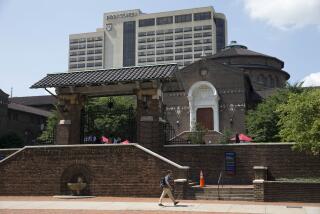Skeleton Shortage Is Giving Medical Schools a Headache
- Share via
This semester, for the first time in recent memory, USC dental students have been sharing skulls. Instead of taking the craniums home, the future dentists have been doing their drills in the laboratory.
It’s all part of a skeleton shortage, verified by spokesmen for local medical and dental schools.
In August of 1985 India, the world’s only exporter of human skeletons, banned the trade. The macabre trade route that linked the teeming streets of Calcutta with the hallowed halls of American medical schools, and netted exporters about $5 million per year, has been interrupted before, most recently for a year in 1976. Reversing the ban would require a decision by India’s Ministry of Commerce, said Shiv S. Mukherjee, spokesman for the Indian Embassy, and there’s no telling when that might occur.
From Alarm to Unease
The shortage became apparent last summer, when medical and dental schools went to restock their skeleton closets for the 1986-87 school year. Industrywide, not much remained.
Some dental educators are alarmed, while most medical school spokesmen are merely uneasy.
For dental students, a ready supply of human skulls is also important, and so far, American importers have not been able to uncover a new source.
Kenneth Byrd, assistant professor of anatomy at USC, compares the loss to the ban on import of rhesus monkeys. “Both bans may involve religious and political pressures. The study of human skeletons is very critical to dentistry,” he said. “Students use them to learn how to do injections and make preparations.”
At USC, where first-year dental students traditionally buy their own skulls, 125 are sharing “about a quarter or a third” of the number of skulls they need, Byrd said.
Byrd is one of several dental school spokesmen who finds plastic substitutes completely unacceptable. “They lack interior reproduction,” he said. “There’s all kinds of tunnels and passages through the bones. You need to know where the nerves and arteries go through.”
Dental research into bone strength or cellular change also requires real skulls, Byrd said.
At UCLA, where dental students borrow skulls for study, there are still enough to go around. Although they doubt it will detract from the overall quality of dental and medical care, UCLA anatomy professors are uneasy about switching to plastics.
“I think more than anything it is going to mean some extra work on our part to make sure (students) understand (the anatomy),” said Anthony Adinolfi, an associate professor who teaches anatomy to dental students.
Human bones may last a millennium in the grave, but in the classroom, the life span is closer to five years. Skulls get chipped, marred or, occasionally, smashed. “Our concern is that we won’t be able to replace what we have, or we’ll be forced to replace them with plastics,” Adinolfi said. “We’re going to be telling students to take care of these things, not just for themselves, but for future classes.”
A Matter of Tradition
Use of plastic substitutes is less upsetting to medical school spokesmen, who say use of human skeletons is mostly a matter of tradition, convenience and variety. Medical students usually do not concentrate on the skull the way dental students do, and most bones reproduce better in plastic than the intricate human skull.
UCLA School of Medicine has nine “articulated natural” (strung-together human) skeletons, and one plastic. Like most anatomy professors, Eldred dislikes using substitutes. “Part of our job is to give students experience with the range of human characteristics,” he said. “You won’t get that with plastics.”
‘A Tedious Process’
The USC School of Medicine recently received four plastic skeletons to supplement eight articulated human skeletons.
For now, spokesmen at both USC and UCLA reject the idea of using skeletons of cadavers willed to the school for study. Without going into detail, Byrd said it would require “a long, tedious, expensive process.”
Shortly after the ban went into effect, Reuters news service quoted Indian sources, who said Indian police had arrested a skeleton trader for smuggling out skeletons of 15,000 children. The ban may also have been inspired by Indian press reports that bodies have been stolen from cremation grounds, or purchased from poor Indians who had no money to buy wood to bury their dead, Reuters said.
There’s no doubt the American industry has suffered. In 1984, the year before the ban, Americans imported $622,000 worth of “skeletons and other preparations of anatomy” from India, according to the Foreign Trade Division of the United States Census Bureau. Through August of 1986, anatomical trade with India had dwindled to $30,589.
“The fact is that we don’t have (articulated human skeletons) anymore, and we don’t expect to be getting them,” said Harry Shoffner, director of advertising for Carolina Biological, one of the nation’s biggest bone dealers. If it were available, an articulated human skeleton on a stand would cost $718, Shoffner said. The plastic equivalent costs $583.
More to Read
Sign up for Essential California
The most important California stories and recommendations in your inbox every morning.
You may occasionally receive promotional content from the Los Angeles Times.













